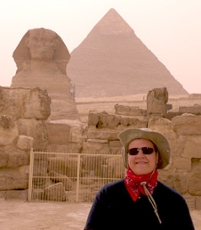Main Content
Gretchen R. Dabbs
Gretchen R. Dabbs, Professor
My research is two-fold, encompassing the fields of bioarchaeology and forensic anthropology. I have worked at the New Kingdom Egyptian archaeological site of Tell el-Amarna since 2008. This city was the capital of Egypt during the Amarna Period (c. 1353BCE) and was built, occupied, and partially abandoned in 15–20 years. As an archaeological site, it provides an unprecedented single-generation lens through which to examine ancient culture, health, biology, and other factors.
The city was built by the pharaoh Akhenaten as part of his re-focusing of the state religion onto his preferred god, the Aten. He ordered a city built in a location where no other god had been worshiped and in doing so, uprooted upwards of 50,000 people to live in this new desert capital. Within a few years, the city consisted of housing and administrative districts, multiple major temples, several palaces, and at least four cemeteries for the non-elite individuals who made up the bulk of the population. My work examines the human skeletal remains from these cemeteries to understand what life was like for people at Amarna during the Amarna period. What did they eat? How did their work impact their bodies? Did they suffer from disease, and if so, which diseases? More broadly, and in the collaborative environment of the Amarna Project, my work contributes to understanding of urbanism in the ancient world and how city-living affects humans, but also how humans affect cities and their development.
As the Director of the Complex for Forensic Anthropology Research, I also investigate the rate and pattern of human decomposition in southern Illinois. Understanding how bodies decompose in different environments can inform several aspects of law enforcement investigations, including an estimation of the postmortem interval (how long someone has been dead) and guiding search parameters for missing individuals. In addition to understanding what should happen to a body after death in our environment, we try to think like criminals to learn how different body disposal methods can affect decomposition over time and how we can identify whether those methods have been applied to a particular individual. For example, how can we differentiate between the skeletal trauma created by vultures consuming carrion versus evidence of trauma before death? We also utilize the skeletal remains of our donors after decomposition studies have been completed to develop techniques for estimating elements of the biological profile, such as age, sex, ancestry, and stature. These descriptors can be compared to reports of missing persons to help identify a person when an unknown individual is recovered.
COURSES
- Introduction to Forensic Anthropology* (Anth 231)
- Introduction to the Archaeology of Ancient Egypt* (Anth 340E)
- Race and Human Variation† (Anth 440B)
- Advanced Forensic Anthropology† (as Anth 455B)
- Human Osteology*† (Anth 455H)
- Forensic Taphonomy† (Anth 456)
- Method and Theory in Biological Anthropology* ‡ (Anth 500A)
- Bioarchaeology Seminar*‡ (Anth 531)
- Current Events in Biological Anthropology Seminar‡ (Anth 532)
- The Archaeology of Ancient Egypt‡ (Anth 540E)

Faner 3539
618-453-3298
gdabbs@siu.edu
CV



